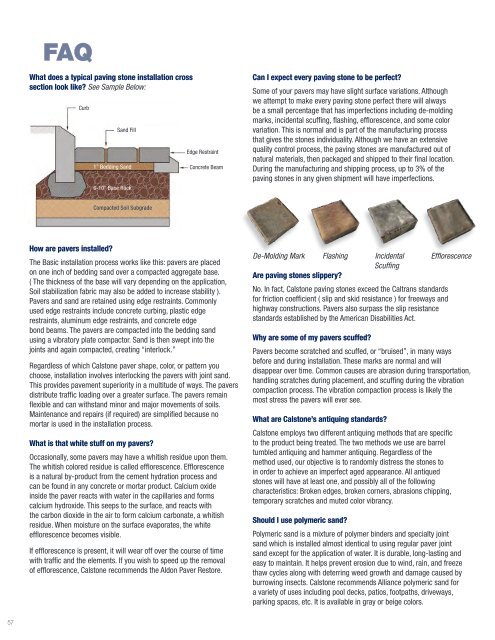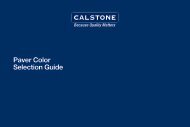Calstone Catalog
Calstone's Hardscape Collection: Paving Stones, Landscape Structures and Retaining Walls.
Calstone's Hardscape Collection: Paving Stones, Landscape Structures and Retaining Walls.
You also want an ePaper? Increase the reach of your titles
YUMPU automatically turns print PDFs into web optimized ePapers that Google loves.
FAQ<br />
What does a typical paving stone installation cross<br />
section look like? See Sample Below:<br />
Curb<br />
Sand Fill<br />
1” Bedding Sand<br />
6-10” Base Rock<br />
Edge Restraint<br />
Concrete Beam<br />
Can I expect every paving stone to be perfect?<br />
Some of your pavers may have slight surface variations. Although<br />
we attempt to make every paving stone perfect there will always<br />
be a small percentage that has imperfections including de-molding<br />
marks, incidental scuffing, flashing, efflorescence, and some color<br />
variation. This is normal and is part of the manufacturing process<br />
that gives the stones individuality. Although we have an extensive<br />
quality control process, the paving stones are manufactured out of<br />
natural materials, then packaged and shipped to their final location.<br />
During the manufacturing and shipping process, up to 3% of the<br />
paving stones in any given shipment will have imperfections.<br />
Compacted Soil Subgrade<br />
How are pavers installed?<br />
The Basic installation process works like this: pavers are placed<br />
on one inch of bedding sand over a compacted aggregate base.<br />
( The thickness of the base will vary depending on the application,<br />
Soil stabilization fabric may also be added to increase stability ).<br />
Pavers and sand are retained using edge restraints. Commonly<br />
used edge restraints include concrete curbing, plastic edge<br />
restraints, aluminum edge restraints, and concrete edge<br />
bond beams. The pavers are compacted into the bedding sand<br />
using a vibratory plate compactor. Sand is then swept into the<br />
joints and again compacted, creating “interlock.”<br />
Regardless of which <strong>Calstone</strong> paver shape, color, or pattern you<br />
choose, installation involves interlocking the pavers with joint sand.<br />
This provides pavement superiority in a multitude of ways. The pavers<br />
distribute traffic loading over a greater surface. The pavers remain<br />
flexible and can withstand minor and major movements of soils.<br />
Maintenance and repairs (if required) are simplified because no<br />
mortar is used in the installation process.<br />
What is that white stuff on my pavers?<br />
Occasionally, some pavers may have a whitish residue upon them.<br />
The whitish colored residue is called efflorescence. Efflorescence<br />
is a natural by-product from the cement hydration process and<br />
can be found in any concrete or mortar product. Calcium oxide<br />
inside the paver reacts with water in the capillaries and forms<br />
calcium hydroxide. This seeps to the surface, and reacts with<br />
the carbon dioxide in the air to form calcium carbonate, a whitish<br />
residue. When moisture on the surface evaporates, the white<br />
efflorescence becomes visible.<br />
If efflorescence is present, it will wear off over the course of time<br />
with traffic and the elements. If you wish to speed up the removal<br />
of efflorescence, <strong>Calstone</strong> recommends the Aldon Paver Restore.<br />
De-Molding Mark Flashing Incidental Efflorescence<br />
Scuffing<br />
Are paving stones slippery?<br />
No. In fact, <strong>Calstone</strong> paving stones exceed the Caltrans standards<br />
for friction coefficient ( slip and skid resistance ) for freeways and<br />
highway constructions. Pavers also surpass the slip resistance<br />
standards established by the American Disabilities Act.<br />
Why are some of my pavers scuffed?<br />
Pavers become scratched and scuffed, or “bruised”, in many ways<br />
before and during installation. These marks are normal and will<br />
disappear over time. Common causes are abrasion during transportation,<br />
handling scratches during placement, and scuffing during the vibration<br />
compaction process. The vibration compaction process is likely the<br />
most stress the pavers will ever see.<br />
What are <strong>Calstone</strong>’s antiquing standards?<br />
<strong>Calstone</strong> employs two different antiquing methods that are specific<br />
to the product being treated. The two methods we use are barrel<br />
tumbled antiquing and hammer antiquing. Regardless of the<br />
method used, our objective is to randomly distress the stones to<br />
in order to achieve an imperfect aged appearance. All antiqued<br />
stones will have at least one, and possibly all of the following<br />
characteristics: Broken edges, broken corners, abrasions chipping,<br />
temporary scratches and muted color vibrancy.<br />
Should I use polymeric sand?<br />
Polymeric sand is a mixture of polymer binders and specialty joint<br />
sand which is installed almost identical to using regular paver joint<br />
sand except for the application of water. It is durable, long-lasting and<br />
easy to maintain. It helps prevent erosion due to wind, rain, and freeze<br />
thaw cycles along with deterring weed growth and damage caused by<br />
burrowing insects. <strong>Calstone</strong> recommends Alliance polymeric sand for<br />
a variety of uses including pool decks, patios, footpaths, driveways,<br />
parking spaces, etc. It is available in gray or beige colors.<br />
57




